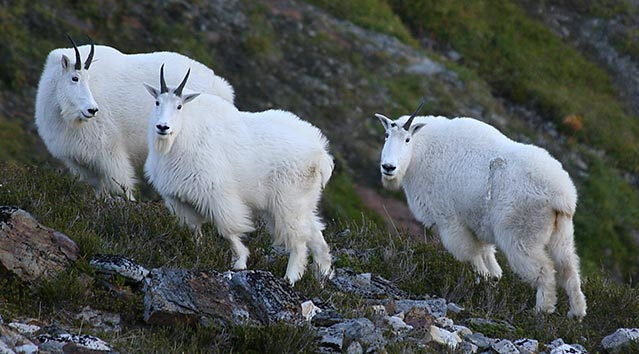
Biologists now have research-based models to predict critical mountain goat habitat in the Chilkat Valley. (Photo courtesy ADF&G)
Every few years, Haines officials decide whether to allow helicopter skiing in new areas of the Chilkat Valley. It’s usually a contentious process where residents debate the economic benefits of heliskiing versus impacts on residents and wildlife.
Now, local decision-makers will have concrete wildlife data to use when developing heliski policy. State biologists created models to predict whether given areas are critical mountain goat or brown bear habitat.
The Alaska Department of Fish and Game biologists who did this research want to be clear on one thing: these studies are not about whether helicopters disturb wildlife. That research has already been done. And it shows mountain goats and bears are affected by helicopter noise. On top of that, the disturbance happens during the winter – the most precarious time of the year for wildlife.
“If animals are right on the edge already,” said biologist Kevin White. “Any amount of disturbance or displacement might actually have some meaningful effects on the animals’ reproduction or survival.”
White started this research in 2010, so his department would have more definitive information when weighing in on Haines heliskiing decisions. The goal was to create a map of Chilkat Valley mountain goat habitat.
“You can see that mountain goats have a really specific preference for places on the landscape,” White said during a September presentation in Haines. “They definitely aren’t using the landscape at random.”
White tracked critical winter goat habitat using GPS collars on about 70 animals and aerial surveys.
Chilkat Valley mountain goats display lots of variety in where they spend the winter. That’s because the climate is transitional, between coastal and interior. Climate affects mountain snowpack, and that affects goats. The animals will go to higher elevations if the snow is light and easy to forage around. If the snow is heavy and hard to move through, goats go to lower elevations.
“Just within the Haines area, we see animals exhibiting three different wintering strategies,” White said.
White found that 25 percent of area goats winter at high elevations, 34 percent at medium elevations, and 41 percent at low elevations.
With the location data, White came up with a model to predict whether a certain area is likely to be winter goat habitat.
“And then ultimately we can predict across the landscape where mountain goat habitat is,” White said. “We can overlay on top of that proposed helicopter zones to determine what impact that might have on mountain goats.”
Mountain goats aren’t the only animals living in places also used as heliski terrain. Brown bears create winter dens high in Chilkat Valley mountains.
In 2015, wildlife biologist Anthony Crupi started a study of brown bear denning sites in the Haines area. The study consisted mostly of aerial surveys.
Crupi says if bears are disturbed while hibernating, it can have serious consequences on their survival.
“They basically go into a den and shut down most of their bodily functions,” Crupi said. “Disturbance during this time period has a potential for a large energetic effect.”
Crupi spotted 90 dens in the mountains between Haines and the Canadian border. Most of them fell between 1,500 and 3,500 feet. The mean elevation was 2,500 feet.
“Bears are very specific to where they locate their dens,” Crupi said. “It’s a negative relationship to elevation…there’s a positive relationship with slope, and bears are lazy, they don’t want to be in places with rugged terrain, unlike mountain goats.”
He used those data points to develop a model that predicts bear denning habitat (similar to White’s goat habitat model.) He mapped the high-probability den habitat and compared that to currently permitted heliski areas.
Twenty-seven percent of dens were in heliski areas.
Crupi also found that 15 percent of prime denning habitat overlaps areas with intense helicopter activity (based on helicopter data from the Haines Borough in 2011.)
So, there are definitely areas where heliskiing and wildlife overlap.
“Those are places where the hardest decisions need to be made,” White said. “Those are the places that have the highest conservation concern.”
The Haines Assembly will have to make those decisions.
Earlier this year, efforts to review map amendment requests were derailed by conflict of interest concerns and the fact that these wildlife studies weren’t yet complete.
Now, the assembly is holding hearings on a new process to review proposed heliski map changes. It will send the requests to two committees first, and get input from agencies like Fish and Game. Fish and Game will use these newly-minted habitat models in its feedback.
But how heavily to weigh wildlife habitat in map decisions is ultimately up to the six elected officials on the Haines Assembly.
View White and Crupi’s slideshow presentation here.








